Opportunity for All: The Question Every City Should Ask, And Answer
Claire Nelson |
Friday, May 09, 2014
How can cities better connect all residents to economic opportunity?
It's the million-dollar question -- the question we hope our civic leaders, policymakers and philanthropists wake up every morning to answer. It is also a question we ought to be asking ourselves, within our own businesses and organizations: How can each of us help create greater opportunity for all?
It is no surprise that we are living in an era of great inequality. Many, including the wealthiest among us (hello Warren Buffett and Bill Gates), have called it
the most pressing challenge of our time. For urbanists who present cities as the answer -- believing, as we do, that density and diversity offer the best conditions for ideas and opportunities to flourish -- we have been tested. From
coast to
coast, the headlines make clear: we are not doing this well. We must do better.
Even in progressive cities that claim to value equity and inclusivity, we are seeing the same economic polarization we saw with the rise of suburban sprawl play out within our own urban neighborhoods. Investment concentrates within sectors and districts, leaving many just out of reach of its grasp. This can feel especially insidious in an urban context, where the space between the flow of capital and the thirst of drought can be as small as a few blocks.
This concerns us, which is why we are pleased to join Meeting of the Minds and
Living Cities to delve deeper into this important question. And really, who better to weigh in on this subject than urban innovators in Detroit? The people working on the ground every day to make Detroit a more vibrant, sustainable and equitable city have important insights. Are we listening to what they have to say?
So we asked a few Detroit innovators to chime in, and, as usual, their answers are smart and thoughtful, touching on everything from resident engagement and effective communication to arts-infused planning and inclusive transformation.
But before we share, we ask you to hold two seemingly opposing ideas in your innovative heads:
If you are a believer in our fundamental premise that there is no single solution but a million little ones, there might appear to be a tension between the words "
all" and "
small." How can a small business or impact project or startup investor even begin to think about creating opportunity for
all? Isn't that a pretty daunting mandate for a micro-venture with a micro-budget? There's nothing small about all.
Here is where the power of a network like UIX comes in. If we see ourselves as part of a constellation of problem-solvers, each with different solutions but a shared set of values, we can begin to see a movement toward equity emerge. The collective impact of thousands of people converting awareness into action is where we start to tip the scales.
In other words, don't count yourself out -- even if your limited purview or resource can't begin to employ or empower the city entire. Any small way you can open the doors a little bit wider is a move in the right direction.
With that, let's turn to our innovators. How do they think cities -- and especially Detroit -- can better connect all residents to economic opportunity?
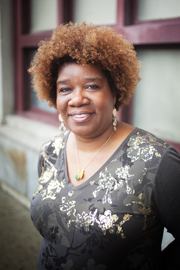 Opportunity through Resident Engagement
Delphia Simmons, Thrive Detroit
True connection requires both parties to give the nod to what the opportunity is. So in order to connect all residents to economic opportunity the city must engage its residents to ascertain what economic opportunity looks like for them. They must ask a few questions and listen for the answers. Only then can we, together, create innovative solutions that connect us all to those opportunities. Here are a few thoughts:
Opportunity through Resident Engagement
Delphia Simmons, Thrive Detroit
True connection requires both parties to give the nod to what the opportunity is. So in order to connect all residents to economic opportunity the city must engage its residents to ascertain what economic opportunity looks like for them. They must ask a few questions and listen for the answers. Only then can we, together, create innovative solutions that connect us all to those opportunities. Here are a few thoughts:
- Economic opportunity must be relevant. Are the opportunities that are being presented relevant to the residents to whom they are being presented? Are the residents' skills relevant to the opportunities?
- Economic opportunity must be relative. What is the proximity of the resident to the opportunities? How many steps will it take for the person who dropped out of high school versus the college graduate to be able to take advantage of the opportunities? Are they reachable?
- Economic opportunity must be ranked. There is no one size fits all for economic opportunity. To provide economic opportunities based upon the assumption of certain skills or abilities is to leave some out of the ranking. It's not about high or low but it is more about the need for economic opportunities to be available to the resident at the starting rank as well as the one at a more advanced rank. The city has to see to it that there are pathways to begin and to advance in rank for all.
Here are a few questions that would need to be asked and answered:- What do they (the city) think economic opportunity looks like for the majority of its residents? This will indicate the city's previous or current direction and assumptions. What has been done to connect residents to economic opportunity based upon these assumptions? What has succeeded? Why has it succeeded? What does that success look like?
- What do the majority of the city's residents say that economic opportunity looks like for them? If they (the city) have not asked then what has been the basis of previous attempts, if any, to connect residents to it?
- Does the city's budget reflect that it values connecting all of its residents to economic opportunity? How much of the city's human resources are used in the community beyond the walls of City Hall to provide and gather information that could lead to economic opportunity for its residents? How are they engaging the residents? Do they make it easy or convenient for all residents to connect with them or is it a "come to me" model? Are resources dedicated to developing a plan to connect all residents to economic opportunity? Who is at the table?
So, in summary: connecting all residents to economic opportunities requires connecting to all residents. It is the difficult work of building relationships and goes beyond building the right opportunity delivery service. Whatever is built must be built together.
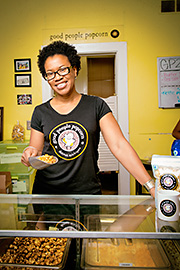 Opportunity through Small-Scale Solutions
Sarida Scott Montgomery, Community Development Advocates of Detroit
Do what you can do now. That's a very simple articulation of my views on this. Using Detroit as an example, we should be thinking on a more micro level. What can we accomplish right now to better connect residents?
One of our problems is figuring out how to get beyond our problems. You will frequently hear in Detroit that our problems are so big, the scale of our issues so huge -- poverty, blight, education, transportation. It's overwhelming. And that has become the biggest problem. Too often this fear of being overwhelmed paralyzes us.
Detroiters are tired of waiting for the silver bullet. We can't get excited about a 50-year plan unless you can break it down into palatable chunks. Make it relevant for us now.
Our poor transportation system will not be fixed overnight, but we also don't want to hear that it will take years to produce an effective system. What can we do to address the current issues for those already utilizing the system? Let's think out the box, let's look at how we can encourage and support ride-sharing, what can we do with alternative buses and vans, can we begin to try things on a district-wide level?
I've been amazed by the number of people who have scoffed at placemaking as too small, too simple, not being big and grand enough to transform systems and have significant impact. Sadly, I believe they are missing the point. It is a process that involves and engages community in solutions that can be immediately implemented. It's an opportunity to try something on a small scale and see if it flies. It is actually doing something with community as opposed to continuing to say "be patient and let us figure out how to revamp a massive and currently dysfunctional system."
Cities could begin to better connect residents to economic opportunities by doing something now -- small things of value -- while continuing to work toward better systems.
Opportunity through Small-Scale Solutions
Sarida Scott Montgomery, Community Development Advocates of Detroit
Do what you can do now. That's a very simple articulation of my views on this. Using Detroit as an example, we should be thinking on a more micro level. What can we accomplish right now to better connect residents?
One of our problems is figuring out how to get beyond our problems. You will frequently hear in Detroit that our problems are so big, the scale of our issues so huge -- poverty, blight, education, transportation. It's overwhelming. And that has become the biggest problem. Too often this fear of being overwhelmed paralyzes us.
Detroiters are tired of waiting for the silver bullet. We can't get excited about a 50-year plan unless you can break it down into palatable chunks. Make it relevant for us now.
Our poor transportation system will not be fixed overnight, but we also don't want to hear that it will take years to produce an effective system. What can we do to address the current issues for those already utilizing the system? Let's think out the box, let's look at how we can encourage and support ride-sharing, what can we do with alternative buses and vans, can we begin to try things on a district-wide level?
I've been amazed by the number of people who have scoffed at placemaking as too small, too simple, not being big and grand enough to transform systems and have significant impact. Sadly, I believe they are missing the point. It is a process that involves and engages community in solutions that can be immediately implemented. It's an opportunity to try something on a small scale and see if it flies. It is actually doing something with community as opposed to continuing to say "be patient and let us figure out how to revamp a massive and currently dysfunctional system."
Cities could begin to better connect residents to economic opportunities by doing something now -- small things of value -- while continuing to work toward better systems.
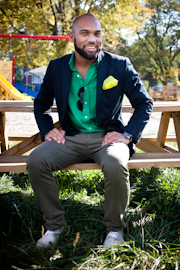 Opportunity through Effective Communication
Wayne Ramocan, Osborn Neighborhood Alliance
To connect to any opportunity, there must be effective communication.
There is a large, white-haired gentleman, reminiscent of Santa, that frequents some of the cafes that I visit. His name is Ivan and I have had many enlightening conversations with him. One day as I was talking to a friend, and Ivan interrupts our conversation to talk about communication -- the etymology of the word, the stem “com-" and related words. He spewed words, becoming an audible thesaurus: "inform, impart, unite, join, participate in” and “to make common." This last one left the greatest impression, because it implies belonging to all.
In a city that is connecting all of its residents to economic opportunity, information and access to opportunity must truly belong to all.
Since 2006, the organization that I serve with, the Osborn Neighborhood Alliance (ONA), has published the Osborn Voice
Opportunity through Effective Communication
Wayne Ramocan, Osborn Neighborhood Alliance
To connect to any opportunity, there must be effective communication.
There is a large, white-haired gentleman, reminiscent of Santa, that frequents some of the cafes that I visit. His name is Ivan and I have had many enlightening conversations with him. One day as I was talking to a friend, and Ivan interrupts our conversation to talk about communication -- the etymology of the word, the stem “com-" and related words. He spewed words, becoming an audible thesaurus: "inform, impart, unite, join, participate in” and “to make common." This last one left the greatest impression, because it implies belonging to all.
In a city that is connecting all of its residents to economic opportunity, information and access to opportunity must truly belong to all.
Since 2006, the organization that I serve with, the Osborn Neighborhood Alliance (ONA), has published the Osborn Voice. When the organization was established, its resident stakeholders urged for one place where all of the information about the Osborn community can be shared and distributed. Everything from news and resident profiles to updated phone numbers for all city, state and federal representatives are included in the free quarterly publication. Additionally, we have launched our mobile accessible website that provides a more real-time version of the print publication.
From the inception of ONA, the first thing that residents wanted to do was make information about the community more accessible. Everyone values information. Effective communication makes access to information possible.
Through our print and internet communications, we are providing opportunity. We are providing residents the opportunity to connect with elected officials, the opportunity to make a positive impact, and the opportunity to portray the neighborhood in more realistic light.
If there is to be economic opportunity, all residents must have information that is easy to access and understand. Access to any opportunity must belong to all.
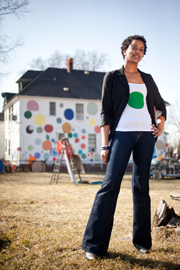 Opportunity through Arts-Infused Planning
by Jessica Brooke Williams, Wayne State University
There is the opportunity for planning professionals to influence larger systematic changes of economic redevelopment in Detroit by incorporating processes that are culturally relevant and/or stimulating for residents living in inner-city neighborhoods -- namely, arts-infused planning.
The technique of merging academic and technical planning techniques with lesser inhibiting and artistic processes is emerging across the United States. This emerging method is helping to create more culturally significant plans that are comprehensible by the resident-majority, and will lend to long-term resident loyalty to land and more successfully implemented plans.
Arts-infused resident engagement surpasses boundaries noted in conventional planning processes to attract increased numbers of residents to participate. As we know art to be an inherent component of cultural identity throughout the world, it can engage significant audiences to personalize their own understanding of where they live and stimulate comprehensive and inclusive analysis of land use and economic issues, assets, and future needs.
The most notable civilizations are distinguished by citizens who collectively define their value (human capital) based on cultural heritage and customary practices, and human capital does not exist without a cultural foundation from which one can identify. Through art, cultural identity can be revealed and determined.
Rather than reactionary or short-term community planning to align with existing plans and policies, I argue that utilizing the arts, proactively, during the plan-making process will create more intrinsic connections to resident needs, and lead to more successfully implemented plans.
Art is part of the very fabric of humanity (Atlas 2011), and exploitation of the arts as a means to reactivate economic vitality will not, alone, sustain public welfare. Instead, art must be upheld as a means to empower cultural association among residents in inner-city areas to stimulate their ability to act as decision-makers of the land around them and enhance their ability to articulate their economic needs.
Opportunity through Arts-Infused Planning
by Jessica Brooke Williams, Wayne State University
There is the opportunity for planning professionals to influence larger systematic changes of economic redevelopment in Detroit by incorporating processes that are culturally relevant and/or stimulating for residents living in inner-city neighborhoods -- namely, arts-infused planning.
The technique of merging academic and technical planning techniques with lesser inhibiting and artistic processes is emerging across the United States. This emerging method is helping to create more culturally significant plans that are comprehensible by the resident-majority, and will lend to long-term resident loyalty to land and more successfully implemented plans.
Arts-infused resident engagement surpasses boundaries noted in conventional planning processes to attract increased numbers of residents to participate. As we know art to be an inherent component of cultural identity throughout the world, it can engage significant audiences to personalize their own understanding of where they live and stimulate comprehensive and inclusive analysis of land use and economic issues, assets, and future needs.
The most notable civilizations are distinguished by citizens who collectively define their value (human capital) based on cultural heritage and customary practices, and human capital does not exist without a cultural foundation from which one can identify. Through art, cultural identity can be revealed and determined.
Rather than reactionary or short-term community planning to align with existing plans and policies, I argue that utilizing the arts, proactively, during the plan-making process will create more intrinsic connections to resident needs, and lead to more successfully implemented plans.
Art is part of the very fabric of humanity (Atlas 2011), and exploitation of the arts as a means to reactivate economic vitality will not, alone, sustain public welfare. Instead, art must be upheld as a means to empower cultural association among residents in inner-city areas to stimulate their ability to act as decision-makers of the land around them and enhance their ability to articulate their economic needs.
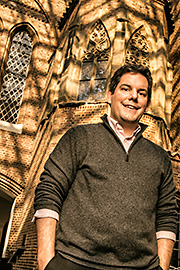 Opportunity through Inclusive Transformation
Bradford Frost, Detroit Corridor Initiative
If you take all the anxiety about the changes unfolding in Detroit, and whether they will ultimately serve a privileged few or the aspirations of all residents, it truly boils down to one central question: How will Detroit's revitalization secure both market growth and preserve long-term affordability, equity and opportunity for all who choose to live in this city?
In a nutshell, that's Detroit's moon shot.
Together, everyone I know working in Detroit is deeply engaged and committed to making Detroit a city where everyone can rise. And, there should be no doubt, Detroit will rise again.
The most urgent demand is that ours is an inclusive transformation. I believe, with all my heart and soul, that the folks working to make our streets more vibrant and our systems more empowering for Detroit residents carry this shared aspiration. Although it will take more time than we'd like and will unfold imperfectly, if we commit to holding ourselves accountable to improving opportunity for all Detroiters, our tenacity will be justly rewarded.
Opportunity through Inclusive Transformation
Bradford Frost, Detroit Corridor Initiative
If you take all the anxiety about the changes unfolding in Detroit, and whether they will ultimately serve a privileged few or the aspirations of all residents, it truly boils down to one central question: How will Detroit's revitalization secure both market growth and preserve long-term affordability, equity and opportunity for all who choose to live in this city?
In a nutshell, that's Detroit's moon shot.
Together, everyone I know working in Detroit is deeply engaged and committed to making Detroit a city where everyone can rise. And, there should be no doubt, Detroit will rise again.
The most urgent demand is that ours is an inclusive transformation. I believe, with all my heart and soul, that the folks working to make our streets more vibrant and our systems more empowering for Detroit residents carry this shared aspiration. Although it will take more time than we'd like and will unfold imperfectly, if we commit to holding ourselves accountable to improving opportunity for all Detroiters, our tenacity will be justly rewarded.
____
Thanks to Meeting of the Minds and Living Cities for asking this important question and including Urban Innovation Exchange in the conversation. To add your voice, please publish your response on May 12 with the hashtag #urbanopportunity and follow the responses on Twitter.
For more information, visit http://cityminded.org/urban-opportunity/.